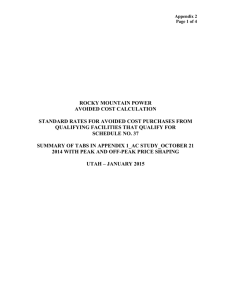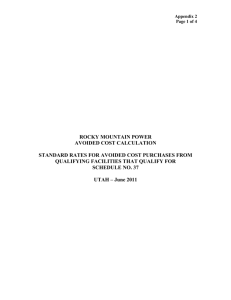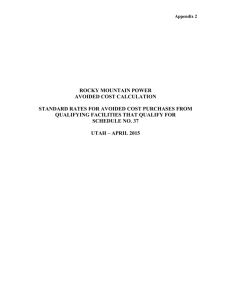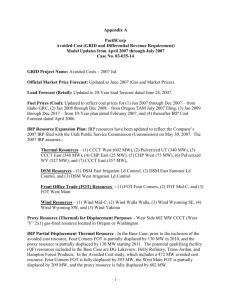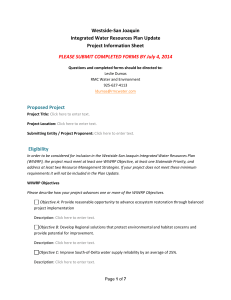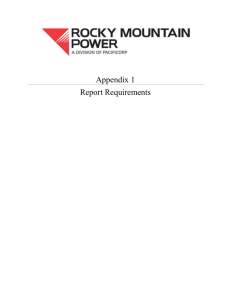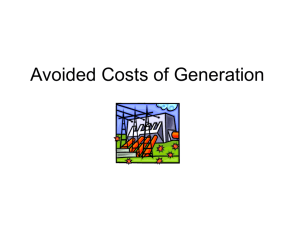Exhibit B - Utah Public Service Commission
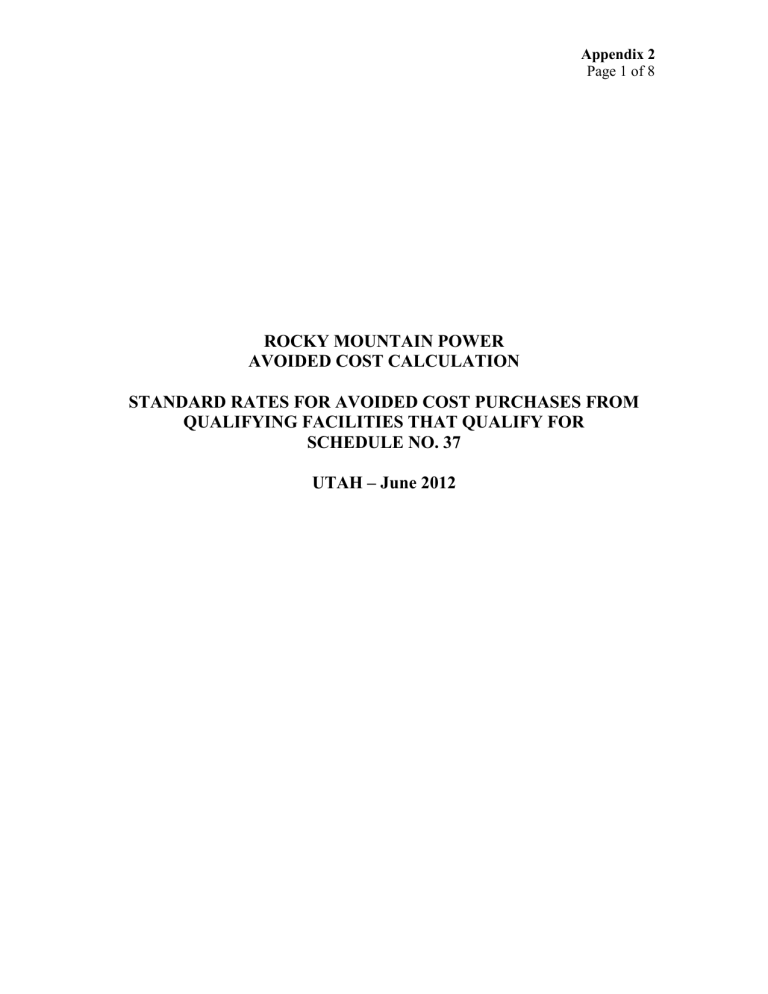
Appendix 2
Page 1 of 8
ROCKY MOUNTAIN POWER
AVOIDED COST CALCULATION
STANDARD RATES FOR AVOIDED COST PURCHASES FROM
QUALIFYING FACILITIES THAT QUALIFY FOR
SCHEDULE NO. 37
UTAH – June 2012
Appendix 2
Page 2 of 8
ROCKY MOUNTAIN POWER
AVOIDED COST CALCULATION
STANDARD RATES FOR AVOIDED COST PURCHASES FROM QUALIFYING
FACILITIES THAT QUALIFY FOR SCHEDULE NO. 37
UTAH – June 2012
In compliance with the Commission’s February 12, 2009, Order in Docket 08-035-78 on
Net Metering Service, PacifiCorp (the “Company”) calculates and files Schedule No. 37 avoided costs annually in order to establish the value or credit for net excess generation of large commercial customers under the Schedule No. 135 Net Metering Service.
1
To perform this calculation, the Company uses the Commission approved Schedule No. 37 avoided cost methodology prescribed in Docket No. 94-2035-03, as modified by Docket
Nos. 03-035-T10 and 12-035-T10.
Loads and Resources (L&R)
The Commission-approved Schedule No. 37 avoided cost methodology requires the
Company to calculate two distinct load and resource (“L&R”) balances. The first L&R balance is an annual energy balance used to determine the periods of resource sufficiency and deficiency.
2 The second L&R balance is a capacity balance calculated on a monthly basis to determine the number of months on which to base the short-run capacity payment.
3
The Company calculates both of these L&R balances using information produced by its Generation and Regulation Initiative Decision (“GRID”) model populated with the existing resource portfolio 4 from its most recently filed Integrated
1 Docket No. 08-035-78, February 12, 2009 Order, U.P.S.C 24 (2009).
2 See Docket No. 94-2035-03, PacifiCorp Exhibit No. 1 (RW-1), Prefiled Direct Testimony of Roger Weaver, U.P.S.C.
10-11 (1994).
3 See Docket No. 03-035-T10, June 1, 2004 Order, U.P.S.C. 16 (2004). The Commission modified the Schedule No. 37 avoided cost methodology to base capacity payments during years of energy sufficiency on the number of months that the Company projected to be capacity deficient. Previously, a three month capacity payment was included if the
Company was capacity deficit at the summer peak.
4 The existing IRP resource portfolio excludes incremental resource additions in the IRP preferred portfolio.
Appendix 2
Page 3 of 8
Resource Plan (“IRP”), updated for known changes that have occurred subsequent to the
IRP filing.
In its November 28, 2012, order in Docket No. 12-035-T10 the Commission clarified the methodology used to determine the resource deficit and surplus period. The
Commission states:
We will rely on the Company’s IRP process and the Company’s planned actions as articulated in its IRP or IRP update action plans as the basis for identifying the type and timing of a deferrable resource and therefore the time period in which the proxy plant method will be used to calculate energy and capacity payments for
Schedule 37 during the period of resource deficiency.
Table 1 presents the Company’s updated load and resource balance calculated in GRID.
Loads are based on the Company’s November 2011 load forecast and resources, including Company-owned generation and long-term sales and purchase contracts were updated to include information available as of May 2012. Table 1 shows an energy surplus from 2012 through 2019, followed by an energy deficit of 95 average megawatts
(“aMW”) in 2020. Summer peak capacity shows a deficit of 790 MW starting in 2012, growing to 2,804 MW in 2020.
In its Order in Docket No. 09-035-T14, the Commission directed the Company “to label
Table 1 with the applicable planning reserve margin assumption (e.g., 12 or 15 percent) in all subsequent filings of Schedule No. 37 rates.” The IRP uses planning reserves to account for operating reserves, regulating reserves, load forecast errors and other planning uncertainties.
5
The Company’s GRID model explicitly models operating reserves, regulating margins, and thermal derates in its balancing algorithm which is approximately equivalent to the planning reserves margin included in the IRP. In the current Schedule No. 37 capacity L&R balance, GRID operating reserves, regulating margins and thermal derates accounted for approximately 12 to 14 percent of system
5 See PacifiCorp 2011 Integrated Resource Plan, Volume I, 99. http://www.pacificorp.com/content/dam/pacificorp/doc/Energy_Sources/Integrated_Resource_Plan/2011IRP/2011IRP-
MainDocFinal_Vol1-FINAL.pdf
Appendix 2
Page 4 of 8 obligation, roughly equivalent to the approximate 13 percent planning reserve margin included in the IRP. Table 12 provides the approximate equivalent planning reserve margins included in the Company’s GRID model.
Table 1a presents the timing of deferrable resources as listed in Table 5.5 of the
Company’s 2011 IRP Update dated March 30, 2012. Table 1a shows that, at the time of the 2011 IRP Update, the Company intended to acquire two combined cycle combustion turbines (“CCCT”); a 637 MW CCCT in 2014 and a 597 MW CCCT in 2016. The
Company has begun construction of the 637 MW Lake Side 2 CCCT scheduled to come online in 2014, so the 597 MW CCCT scheduled for 2016 is the Company’s next deferrable resource in the 2011 IRP Update.
In its order in Docket No. 12-035-T10 the Commission clarified that if there is a difference between the results of the L&R study contained in Table 1 and the timing of the next deferrable resource as listed in the IRP contained in Table 1a, then the results of the IRP (Table 1a) would govern. Specifically the Commission states:
(W)hen there is a conflict between the two analyses regarding the timing of a deferrable resource, the type and timing of the next deferrable resource included in the Company’s most recently filed IRP action plan will govern.
Avoided Cost Calculation
Based on the timing of the next deferrable resource shown in Table 1a , the avoided cost calculation is separated into two distinct periods: (1) the Short Run – a period of resource sufficiency (2012 through 2015); and (2) the Long Run – a period of resource deficiency
(2016 and beyond).
1.
Short Run Avoided Costs
During periods of resource sufficiency, the Company’s avoided energy costs are based on the displacement of purchased power and existing thermal resources as modeled by the company’s GRID model. The model input data includes the monthly load and resource
Appendix 2
Page 5 of 8 data, which are the basis for the annual summary of loads and resources shown in
Table 1 .
To calculate short-run avoided costs, two production cost studies are prepared. The only difference between the two studies is an assumed 10 aMW increase, at zero running cost.
The 10 aMW resource serves as a proxy for qualifying facility generation. The avoided energy cost could be viewed as the highest variable cost incurred to serve total system load from existing and non-deferrable resources. The outputs of the production cost model run are provided as Table 2 .
Capacity costs in this period are based on capacity purchases for the number of months that the company is capacity deficit. For example, if the company is capacity deficit for five months in a given year, the purchases would be for five-twelfths of the year and the annual value as shown in Table 3 would be five-twelfths of the capacity cost of a simple cycle combustion turbine (“SCCT”).
Table 11 details the monthly capacity balances used to determine the short-run capacity payment.
In the Commission’s Order dated October 31, 2011 in Docket 11-035-T06 the
Commission directed the Company to show how hedging costs relate to the Schedule 37 rates. Hedging costs are included as a fixed cost in the GRID studies used to calculate short-run avoided energy costs in the same manner as they are included in general rate case proceedings. In the calculation of short-run avoided costs, natural gas hedging costs allocated to gas-fired resources fluctuate to the extent plant dispatch is altered by the addition of the 10 megawatt zero cost resource.
Appendix 2
Page 6 of 8
2.
Long Run Avoided Costs
During the resource deficiency period (2016 and beyond), avoided costs are the fixed and variable costs of a proxy resource that could be avoided or deferred. The current proxy resource is a CCCT 6 .
Since CCCTs are built as base load units that provide both capacity and energy, it is appropriate to split the fixed costs of this unit into capacity and energy components. The fixed cost of a SCCT, which is usually acquired as a capacity resource, defines the portion of the fixed cost of the blended resource that is assigned to capacity. Consistent with the Commission Order in Docket No. 03-035-14, 50% of the fixed costs associated with the construction of the CCCT resource in excess of the fixed costs of a SCCT is assigned to energy and is added to the variable production (fuel) cost of the CCCT resource to determine the total avoided energy costs. Table 3 shows the capitalized energy costs.
The fuel cost of the CCCT defines the avoided variable energy costs. The gas price forecast used as the basis for the CCCT fuel cost is discussed later in this document.
Table 4 shows the CCCT fuel cost, the addition of capitalized energy costs at an assumed
50.3% capacity factor and the total avoided energy costs.
Because energy generated by a qualifying facility may vary, the total avoided costs at
75%, 85% and 95% capacity factor are prepared to illustrate the impact of differing generation levels. This calculation is shown in Table 5 .
Avoided energy costs can be differentiated between on-peak and off-peak periods. To make this calculation, the Company assumed that all capacity costs are incurred to meet on-peak load requirements. On an annual basis, approximately 57% of all hours are on-
6 597 MW CCCT (Dry "F" 2x1) - East Side Options (4500') as listed in the 2011 IRP Update. Fuel costs are from the
Company’s May 2012 Official Forward Price Curve.
Appendix 2
Page 7 of 8 peak and 43% are off-peak. Table 6 shows the calculation of on-peak and off-peak avoided energy prices.
For informational purposes, Table 7 shows a comparison between the avoided costs currently in effect in Utah and the proposed avoided costs in this filing. The 20 year nominal levelized prices are calculated using a 7.154% discount rate. The discount rate was updated from 7.17% in the prior filing as a result of the 2011 IRP Update.
Table 8 shows the calculation of the total fixed costs and fuel costs of the CCCT and
SCCT that are used in Table 3 and Table 4 . In this filing, the Company’s next deferrable resource is a CCCT located on the east side of the Company’s system. This result is consistent with the Company’s addition of an east side CCCT in 2016 as modeled in the
2011 IRP Update. Costs and the payment factors are consistent with modeling assumptions used in the 2011 IRP Update. Fixed pipeline costs are included as fixed
O&M to be consistent with the method used in the 2011 IRP Update.
Price Forecast for Electricity and Natural Gas
The electricity and natural gas prices used in this filing are from the Company’s Official
Forward Price Curve dated May 10, 2012. Both the electricity and natural gas prices are inputs to the Company’s GRID model in the calculation of the proposed avoided costs in this filing. Table 9 shows the natural gas price used to calculate the fuel costs of the
CCCT that is the proxy resource for the Long Run avoided costs, and Table 10 shows the electricity prices at Mid Columbia and Palo Verde that are used in the Company’s avoided costs calculation on a heavy-load hour and light-load hour basis.
For the period from July 2012 through May 2018, the official forward prices are based on the information from the market forward transactions. For the period from June 2018 through May 2019, the official forward prices are the average of market information and
Appendix 2
Page 8 of 8 the long-term price forecast. For period beginning in May 2019, the official forward prices are based on long-term price forecast.
